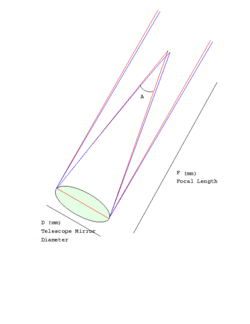Astronomy:Plate scale
The plate scale of a telescope connects the angular separation of an object with the linear separation of its image at the focal plane.
If focal length [math]\displaystyle{ f }[/math] is measured in mm, the plate scale in radians per mm is given by angular separation θ and the linear separation of the image at the focal plane s, or by simply the focal length f:
- [math]\displaystyle{ p =\frac{\theta}{s} =\frac{1}{f}\ , }[/math]
since
- [math]\displaystyle{ s =f \theta\ . }[/math]
Plate scale is usually expressed in arcseconds per mm:
- [math]\displaystyle{ p \approx\frac{206265}{f}, }[/math]
where f is in mm,[1] or expressed in arcseconds per pixel after further division through the pixel scale.
Plate scale on JWST FGS/NIRISS
The plate scale of the James Webb Space Telescope component Fine Guidance Sensor and Near Infrared Imager and Slitless Spectrograph is about 0.065 arcsec/pixel.[2] It uses a 2048 x 2048 pixel array with a pixel size of 18 microns a side with a field of view of 2.2' x 2.2' [3]
See also
Notes
- ↑ Carroll, Bradley; Ostlie, Dale. An Introduction to Modern Astrophysics (1st ed.). p. 163.
- ↑ http://www.stsci.edu/jwst/instruments/niriss/instrumentdesign [|permanent dead link|dead link}}]
- ↑ http://www.stsci.edu/jwst/instruments/niriss/instrumentdesign [|permanent dead link|dead link}}]
 |


